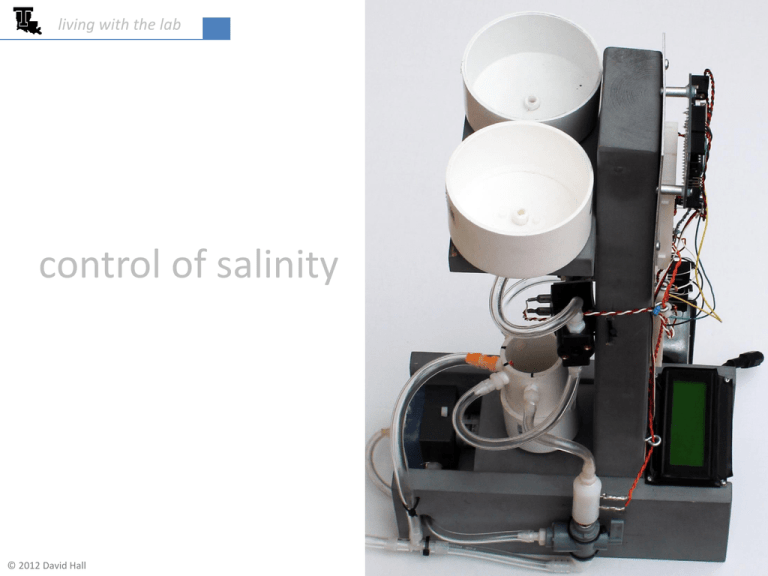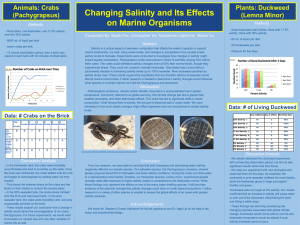living with the lab
advertisement

living with the lab
control of salinity
© 2012 David Hall
living with the lab
General Idea
DI water
• The objective is to keep the salinity close to a
setpoint which will provided by your instructor
salt water
(1% NaCl)
• The salinity sensor measures the analog
voltage output of the salinity circuit
• Opening DI solenoid valve decreases salinity
• Opening salty solenoid valve increases salinity
0.05 wt % NaCl ≤ setpoint for salinity ≥ 0.15 wt% NaCl
(your instructor will provide a setpoint, such as 0.09 wt% NaCl)
2
living with the lab
review of conductivity sensor wiring & programming
void setup() {
Serial.begin(9600);
pinMode(1,OUTPUT);
Serial.write(12);
Serial.write(128);
Serial.write("Conductivity Sensor");
Serial.write(152);
Serial.write("Calibration");
Serial.write(189);
Serial.write("analog input=");
Serial.write(22);
pinMode(3, OUTPUT);
}
// use a baud rate of 9600 bps
// set pin1 as an output (pin1=TX)
// clear screen & move to top left position
pin 3 = 5V when HIGH
// move cursor to row 0, position 1
// print a text string starting at (0,1) (set high periodically to measure conductivity)
// move cursor to row 1, position 4
// print a text string starting at (1,4)
// move cursor to row 3, position 1
// print text string at (3,1)
// turn cursor off to keep screen clean
analog input 0
(measures voltage across 10kΩ resistor)
void loop() {
digitalWrite(3,HIGH);
delay(100);
int analogS=analogRead(0);
digitalWrite(3,LOW);
Serial.write(202);
Serial.print(analogS);
Serial.write(" ");
delay(1000);
}
• write info to LCD
// apply 5V to the conductivity sensor
// hold the voltage at pin 3 for 0.1s
// read voltage on + side of 10kohm resistor
// turn off power to the conductivity sensor
// move cursor to row 3, position 14
// print the analog input reading (0 to 1023)
// overwrite previously printed numbers
// delay 1 second between measurements
10 kΩ
• energize & read salinity sensor
3
living with the lab
review of conductivity sensor calibration
• Collect analog output of salinity circuit, with output numbers ranging
from 0 to 1023 (the Arudino has a 10-bit ADC)
• Perform linear regression to determine the expected output of the
conductivity circuit as a function of salinity
linear
polynomial
salt
concentration Arduino
(fractional) output
0.0000
2.5
0.0005
465
0.0010
511.5
0.0015
537.5
power
4
living with the lab
examine fits over possible salinity range
Consider how your fit behaves beyond 0.15 wt% salt since your salinity may increase
well beyond 0.15% when salty water is added
output vs salt concentration
output vs salt concentration
800
600
700
500
500
raw data
400
linear
300
polynomial
200
power
100
output of circuit
output of circuit
600
400
300
200
100
0
0.00
0.10
0.20
0.30
0.40
0.50
salt concentration (% wt)
0
0.00
0.05
0.10
0.15
0.20
salt concentration (% wt)
• Do you see any potential problems?
• Which fit seems to be the best? Why?
5
living with the lab
equations needed for salinity control sketch
output vs salt concentration
use four or five digits for these fitting constants
using algebra, invert this equation to obtain
Salt concentration vs output
𝑜𝑢𝑡𝑝𝑢𝑡 = 1274.1 ∙ 𝑠𝑎𝑙𝑖𝑛𝑖𝑡𝑦 0.1325
equation to compute setpoints for control
𝑠𝑎𝑙𝑖𝑛𝑖𝑡𝑦 = 3.6686 10
−24
∙ 𝑜𝑢𝑡𝑝𝑢𝑡 7.5472
equation to compute salinity from sensor output
6
living with the lab
t1 > t2 since valve is left open an amount
of time proportional to the error
Control of Salinity
valve = open
salty water valve status
valve = closed
t2
valve = open
valve = closed
DI water valve status
t1
salinity (%wt NaCl)
system lag
hysteresis
0.15
deadtime
compensation
error
0.10
deadband
0.05
upper control limit (UCL)
setpoint = 0.09
error
error
lower control limit (LCL)
random variation
of conductivity
system upset by
externally adding salty water
system upset by
externally adding DI water
0.00
time
7
living with the lab
key points
• The valve is left open an amount of time that is proportional to the error.
• small error = valve is open a short amount of time
• large error = valve is open a long amount of time
• The DI valve is left open longer than the salty valve when correcting for
the same magnitude of error (DI=0%, setpoint = 0.09%, salty = 1%).
• The system has memory . . . it takes time for the salinity of the water to
become uniform (mixing, water in pump and tubing). The lag time is
called hysteresis.
• Control is more stable if we wait for the system to stabilize after opening
a valve. The deadtime compensation is set to allow the system to come
to equilibrium before responding to error.
• The upper and lower control limits are set so that random error will not
cause the valves to open unnecessarily; these limits are often set three
standard deviations of the error away from the setpoint. The difference
between UCL and LCL is called the deadband.
8
living with the lab
control strategy
• The setpoint will be assigned by your instructor. Assume 0.09% NaCl here.
• Compute the UCL, setpoint and LCL values for control of salinity. UCL and LCL depend
on the size of the deadband.
• For demonstration purposes, assume that the UCL and LCL are 0.01%NaCl from the
setpoint:
𝑈𝐶𝐿 = 1274.1 ∙ 0.0009 + 0.0001
𝑠𝑒𝑡𝑝𝑜𝑖𝑛𝑡 = 1274.1 ∙ 0.0009
0.1325
0.1325
= 510
= 503
𝐿𝐶𝐿 = 1274.1 ∙ 0.0009 − 0.0001
0.1325
= 495
• Control strategy:
•
•
if analogS > UCL (or 510) then open the DI valve an amount proportional to the error
If analogS < LCL (or 495), then open the salty valve an amount proportional to the error
9
living with the lab
setting UCL and LCL by examining random error
A better way to determine UCL and LCL are by collecting analogS values for a salinity near the
setpoint and then computing the standard deviation (s) of the “error” of analogS values.
•
Using this approach, 99.7% of random error will fall between the LCL and UCL, which means that
your solenoid valve will be triggered due to a false alarm only 0.3% of the time.
512
510
analog output
Example Readings to Illustrate Procedure
•
508
506
analog output
504
502
500
498
496
494
0
5
10
15
20
reading
𝑠𝑒𝑡𝑝𝑜𝑖𝑛𝑡 = 1274.1 ∙ 0.0009 0.1325 = 503
𝑈𝐶𝐿 = 𝑠𝑒𝑡𝑝𝑜𝑖𝑛𝑡 + 3σ = 503 + 8 = 511
𝐿𝐶𝐿 = 𝑠𝑒𝑡𝑝𝑜𝑖𝑛𝑡 − 3σ = 503 − 8 = 495
10
living with the lab
setting deadtime compensation
• It takes time for your system to settle out after the salinity changes.
• Assume the system whose response is depicted in the graph below is “upset” at 18
seconds due to a sudden addition of salty water.
• At about 30 seconds, the salinity values stabilize (with continued random error at the
new salinity level).
• For this example, the deadtime compensation would be set to 12 seconds (30s - 18s).
• This means that you would want to allow 12 seconds between salinity corrections.
525
deadtime = 12 s
analog output
520
515
510
analog output
UCL
505
LCL
500
mean
495
time when salty water was added
490
0
5
10
15
20
25
30
35
40
time (s)
11
living with the lab
strength of response to error
• We will compute the amount of salty water that should be added to the current
mixture to correct the salinity
salinity (%wt NaCl)
a correction that is too strong was applied
0.15
error
0.10
upper control limit (UCL)
setpoint = 0.09
lower control limit (LCL)
0.05
overshoot (undesirable)
0.00
a second correction is applied – this one is also too strong
time
• Over correcting repeatedly causes the system to oscillate about the setpoint
12
living with the lab
apply a response proportional to error
salinity (%wt NaCl)
• We will compute the amount of salty water that should be added to the current
mixture to completely correct the salinity
• We will open the solenoid valve long enough to remove a percentage of the error
• For example, if the salinity is 0.152% and the setpoint is 0.09%, then applying an 80%
correction will lower the salinity to 0.102%, which is computed as
correction = (.00152-(.00152-.0009)*.8)
• We call the proportionality constant the gain; gain is a common term used when
working with industrial controllers
0.15
error
0.10
80% of error
upper control limit (UCL)
setpoint = 0.09
lower control limit (LCL)
0.05
0.00
time
13
living with the lab
teams of 2
Class Problem Assume that your fishtank system has a setpoint of 0.09% NaCl.
Your instructor comes by your table and upsets your system by adding a good
dose of DI water. The conductivity circuit returns an analog output that
corresponds to a salinity of 0.04% NaCl (which is below LCL).
a) What is the target concentration if you have a gain of 0.80 (80%)?
b) Using this gain, how much salty water (1% NaCl) should be added?
c) How long should you leave the valve open if the flow rate is 0.2L/min?
Recommended assumptions:
The water leaves at the overflow is a mixture of water from the salty tank and the
fishtank.
The most salty the overflow water can be is 1% NaCl, and the least salty it can be
is 0.04% NaCl. Assume that 15% of the overflow water is 1% NaCl and that the rest
is 0.04% NaCl.
Neglect density differences between incoming and outgoing water; that is, the
mass of water that comes in from the salty tank is equal to the mass of water that
leaves through the overflow.
14
living with the lab
sketch control structure
• Compute setpoint, UCL and LCL
use your own data
𝑠𝑒𝑡𝑝𝑜𝑖𝑛𝑡 = 1274.1 ∙ 0.0009 0.1325 = 503
𝑈𝐶𝐿 = 𝑠𝑒𝑡𝑝𝑜𝑖𝑛𝑡 + 3σ = 503 + 8 = 511
𝐿𝐶𝐿 = 𝑠𝑒𝑡𝑝𝑜𝑖𝑛𝑡 − 3σ = 503 − 8 = 495
• Measure salinity to get analogS (the analog output of the conductivity circuit)
• If analogS > UCL or < LCL & if time since last correction > deadtime then . . .
• Compute the %wt NaCl
𝑠𝑎𝑙𝑖𝑛𝑖𝑡𝑦 = 3.6686 10
−24
∙ 𝑜𝑢𝑡𝑝𝑢𝑡 7.5472
use your own data
• Compute the target salinity based on your gain
• Compute the time that your salty or DI solenoid valves needs to be left open
• Open the DI or salty valve for the computed time
15
living with the lab
to do for salinity control:
• Bring fishtank, water bottles, multimeter & computer to class next time
• Determine flow rate through your solenoid valve (mass per unit time)
• Recalibrate your system
• Determine your fits
• salinity as a function of analogS
• analogS as a function of salinity
• Collect data around 0.10% NaCl to determine the standard deviation of the
conductivity output so that the UCL and LCL can be determined
• Determine the deadtime compensation (system response time)
• Write your control sketch
THE END
16
living with the lab
review of conductivity sensor wiring & programming (for old IDE)
If you haven’t downloaded the Arduino Integrated Development Environment (IDE) in a while, then try
program below.
void setup() {
Serial.begin(9600);
pinMode(1,OUTPUT);
Serial.print(12, BYTE);
Serial.print(128,BYTE);
Serial.print("Conductivity Sensor");
Serial.print(152,BYTE);
Serial.print("Calibration");
Serial.print(189,BYTE);
Serial.print("analog input=");
Serial.print(22,BYTE);
pinMode(3, OUTPUT);
}
// use a baud rate of 9600 bps
// set pin1 as an output (pin1=TX)
// clear screen & move to top left position
pin 3 = 5V when HIGH
// move cursor to row 0, position 1
// print a text string starting at (0,1) (set high periodically to measure conductivity)
// move cursor to row 1, position 4
// print a text string starting at (1,4)
// move cursor to row 3, position 1
// print text string at (3,1)
// turn cursor off to keep screen clean
analog input 0
(measures voltage across 10kΩ resistor)
void loop() {
digitalWrite(3,HIGH);
delay(100);
int analogS=analogRead(0);
digitalWrite(3,LOW);
Serial.print(202,BYTE);
Serial.print(analogS);
Serial.print(" ");
delay(1000);
}
• write info to LCD
// apply 5V to the conductivity sensor
// hold the voltage at pin 3 for 0.1s
// read voltage on + side of 10kohm resistor
// turn off power to the conductivity sensor
// move cursor to row 3, position 14
// print the analog input reading (0 to 1023)
// overwrite previously printed numbers
// delay 1 second between measurements
• energize & read salinity sensor
10 kΩ
17









